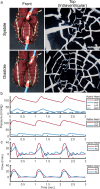A soft robotic total artificial hybrid heart
- PMID: 40461487
- PMCID: PMC12134382
- DOI: 10.1038/s41467-025-60372-6
A soft robotic total artificial hybrid heart
Abstract
End-stage heart failure is a deadly disease. Current total artificial hearts (TAHs) carry high mortality and morbidity and offer low quality of life. To overcome current biocompatibility issues, we propose the concept of a soft robotic, hybrid (pumping power comes from soft robotics, innerlining from the patient's own cells) TAH. The device features a pneumatically driven actuator (septum) between two ventricles and is coated with supramolecular polymeric materials to promote anti-thrombotic and tissue engineering properties. In vitro, the Hybrid Heart pumps 5.7 L/min and mimics the native heart's adaptive function. Proof-of-concept studies in rats and an acute goat model demonstrate the Hybrid Heart's potential for clinical use and improved biocompatibility. This paper presents the first proof-of-concept of a soft, biocompatible TAH by providing a platform using soft robotics and tissue engineering to create new horizons in heart failure and transplantation medicine.
© 2025. The Author(s).
Conflict of interest statement
Competing interests: The authors declare no conflict of interest.
Figures







References
-
- Bragazzi, N. L. et al. Burden of heart failure and underlying causes in 195 countries and territories from 1990 to 2017. Eur. J. Preventive Cardiol.28, 1682–1690 (2021). - PubMed
-
- Tsao, C. W. et al. Heart Disease and Stroke Statistics—2022 update: a report from the American Heart Association. Circulation145, e153–e639 (2022). - PubMed
-
- Dal Sasso, E., Bagno, A., Scuri, S. T. G., Gerosa, G. & Iop, L. The biocompatibility challenges in the total artificial heart evolution. Annu Rev. Biomed. Eng.21, 85–110 (2019). - PubMed
-
- Cianchetti, M., Laschi, C., Menciassi, A. & Dario, P. Biomedical applications of soft robotics. Nat. Rev. Mater.3, 143–153 (2018).
MeSH terms
Substances
Grants and funding
LinkOut - more resources
Full Text Sources
Medical

